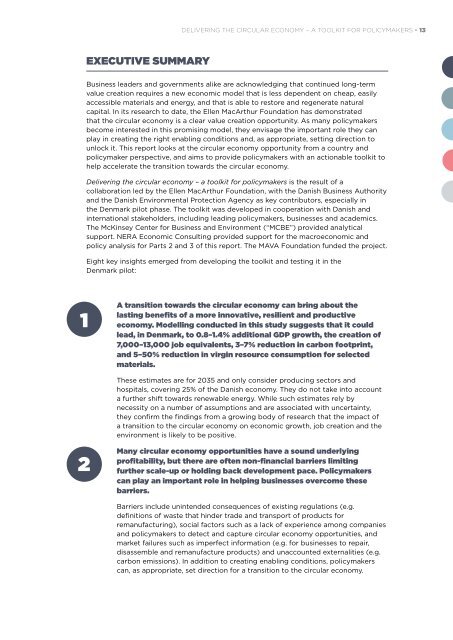DELIVERING THE CIRCULAR ECONOMY A TOOLKIT FOR POLICYMAKERS
20150924_Policymakers-Toolkit_Active-links
20150924_Policymakers-Toolkit_Active-links
You also want an ePaper? Increase the reach of your titles
YUMPU automatically turns print PDFs into web optimized ePapers that Google loves.
<strong>DELIVERING</strong> <strong>THE</strong> <strong>CIRCULAR</strong> <strong>ECONOMY</strong> – A <strong>TOOLKIT</strong> <strong>FOR</strong> <strong>POLICYMAKERS</strong> • 13<br />
EXECUTIVE SUMMARY<br />
Business leaders and governments alike are acknowledging that continued long-term<br />
value creation requires a new economic model that is less dependent on cheap, easily<br />
accessible materials and energy, and that is able to restore and regenerate natural<br />
capital. In its research to date, the Ellen MacArthur Foundation has demonstrated<br />
that the circular economy is a clear value creation opportunity. As many policymakers<br />
become interested in this promising model, they envisage the important role they can<br />
play in creating the right enabling conditions and, as appropriate, setting direction to<br />
unlock it. This report looks at the circular economy opportunity from a country and<br />
policymaker perspective, and aims to provide policymakers with an actionable toolkit to<br />
help accelerate the transition towards the circular economy.<br />
Delivering the circular economy – a toolkit for policymakers is the result of a<br />
collaboration led by the Ellen MacArthur Foundation, with the Danish Business Authority<br />
and the Danish Environmental Protection Agency as key contributors, especially in<br />
the Denmark pilot phase. The toolkit was developed in cooperation with Danish and<br />
international stakeholders, including leading policymakers, businesses and academics.<br />
The McKinsey Center for Business and Environment (“MCBE”) provided analytical<br />
support. NERA Economic Consulting provided support for the macroeconomic and<br />
policy analysis for Parts 2 and 3 of this report. The MAVA Foundation funded the project.<br />
Eight key insights emerged from developing the toolkit and testing it in the<br />
Denmark pilot:<br />
1<br />
A transition towards the circular economy can bring about the<br />
lasting benefits of a more innovative, resilient and productive<br />
economy. Modelling conducted in this study suggests that it could<br />
lead, in Denmark, to 0.8–1.4% additional GDP growth, the creation of<br />
7,000–13,000 job equivalents, 3–7% reduction in carbon footprint,<br />
and 5–50% reduction in virgin resource consumption for selected<br />
materials.<br />
These estimates are for 2035 and only consider producing sectors and<br />
hospitals, covering 25% of the Danish economy. They do not take into account<br />
a further shift towards renewable energy. While such estimates rely by<br />
necessity on a number of assumptions and are associated with uncertainty,<br />
they confirm the findings from a growing body of research that the impact of<br />
a transition to the circular economy on economic growth, job creation and the<br />
environment is likely to be positive.<br />
2<br />
Many circular economy opportunities have a sound underlying<br />
profitability, but there are often non-financial barriers limiting<br />
further scale-up or holding back development pace. Policymakers<br />
can play an important role in helping businesses overcome these<br />
barriers.<br />
Barriers include unintended consequences of existing regulations (e.g.<br />
definitions of waste that hinder trade and transport of products for<br />
remanufacturing), social factors such as a lack of experience among companies<br />
and policymakers to detect and capture circular economy opportunities, and<br />
market failures such as imperfect information (e.g. for businesses to repair,<br />
disassemble and remanufacture products) and unaccounted externalities (e.g.<br />
carbon emissions). In addition to creating enabling conditions, policymakers<br />
can, as appropriate, set direction for a transition to the circular economy.



